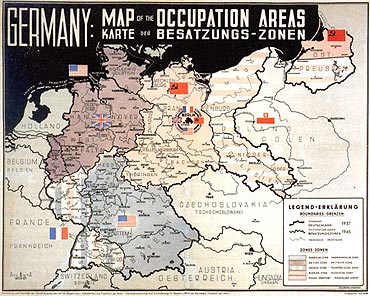Schrift: größer/kleiner
Inhaltsverzeichnis
Sie sind hier: WirRheinländer > english version > Allied Occupation and „Trizonesia“ (1945 - 1949)
Allied Occupation and "Trizonesia" (1945-1949)
5th June 1945: Germany is divided into four Zones
The four victorious powers of the Second World War, USA, Soviet Union, Great Britain and France, assumed control of the highest government power in Germany with the "Berlin Declaration" of the 5th of June in 1945. This included all military, political and administrative authority over the country at regional, local and parish levels. On the same day Germany was divided into four occupied zones.

Every Allied occupying power was awarded sovereignty over one part of Germany: the eastern zone was assigned to the USSR, the north-western part, with the later Länder of Schleswig-Holstein, Lower Saxony, North Rhine-Westphalia and Hamburg, to the British, the south-western part to the Americans, while the west came under French administration. In each occupied zone there was a military governor, who at the same time was the military commander-in-chief. In Berlin sat the Allied Control Council, which was to regulate all the questions that affected Germany as a whole.
At first the plan for Germany had been quite different: at the conference of Québec in 1944 the Allies had agreed to a division of three occupied zones, before General de Gaulle succeeded in asserting the right to a French zone, which was squeezed in between the British and American zones. This division of the Rhineland was one of the causes of the later formation of the Länder North Rhine-Westphalia in the British zone and Rhineland-Palatinate in the American zone. Furthermore, until early in 1945 the British had still presumed that there would be a central administration which was supposed to treat Germany as a political and economic unity. However, it soon became apparent that the Allied Control Council was unable to prevent the zones from drifting apart.
Before the capitulation of the Germans on 8th May, armed clashes in the west were already over and the time of the occupation had begun. In the process, most of the occupying forces in the Rhineland and Westphalia were American, who had captured the Ruhr region. The fighting troops were followed by units of military administration, whose short duration nevertheless left its traces. For instance, Konrad Adenauer was reinstated as Mayor of Cologne by the Americans. At the end of May the British took over Westphalia and on 21st June the northern Rhineland.
Under the supervision of local military commanders, the broken down local administration had to be reorganised, the civilian population and prisoners of war had to be provided for, transport infrastructure had to be rebuilt and production in the economy had to be cranked up again. The two most important men in the British occupied zone were the Military Governor, Field Marshal Montgomery, whose residence was in Bad Oeynhausen, Westphalia, and his deputy, General Robertson, who headed the British section of the Control Commission for Germany in Berlin. The commanders of the military governments were Sir John Barraclough in Düsseldorf for the province of North Rhine, and George Leidigham (later Cecil Chatwick) in Münster for the province of Westphalia.


